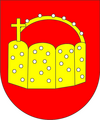Ore office
The highest court offices in the Holy Roman Empire , which existed until 1806, were called Erzamt or Reichserzamt . Each ore office was linked to the electoral dignity . With the exception of the Imperial Arch Chancellor for Germany, the official titles were purely symbolic from the later Middle Ages. However, ceremonial activities at the coronation of the Roman king in Aachen and from 1562 in Frankfurt am Main were connected with them.
history
middle Ages
In the Middle Ages , the electors usually took part in the ceremony personally, but after the Reformation (since a Catholic mass took place as part of the coronation) they were almost only represented by certain noble families: the symbolic and ceremonial tasks of the arch offices on official occasions , for example at the coronation of the Roman-German kings and emperors , were therefore inherited early on as an inheritance - corresponding to the respective arch office - to certain noble families on behalf of the electors (the owners of the " arch offices " of the Holy Roman Empire). In the course of time, these families also occasionally passed on their office, so that it was carried out by deputies of the deputies at the coronation ceremony. On the counterparts to the Erzämtern, there were other ceremonial hereditary offices .
Golden bull
Under Emperor Charles IV , the following distribution of ore offices was laid down in the Golden Bull of 1356:
- The three ecclesiastical electors were Arch Chancellors (→ Imperial Arch Chancellors ) for one of the three parts of the empire:
- the Archbishop of Mainz for Germany - Archicancellarius per Germaniam ,
- the Archbishop of Cologne for Imperial Italy - Archicancellarius per Italiam ,
- the Archbishop of Trier for Burgundy (ie the kingdom of Arelat on the Rhone , which fell to the Reich in 1033, with the capital Arles ) - Archicancellarius per Galliam .
- See also: Arch Chancellor (Franconian Empire) for the Carolingian Arch Chancellor.
- The four original secular electors held the following offices:
- the Count Palatine near the Rhine was an Archdean (→ Truchsess ) - Archidapifer , official sign: golden orb in a red field.
- the Duke of Saxony was Archmarschall - Archimareschallus , official sign: two crossed red swords ( imperial racing flag ).
- the Margrave of Brandenburg was Arch Chamberlain (→ Chamberlain ) - Archicamerarius , official sign: golden imperial scepter in a blue field.
- the king of Bohemia was Archipincern (→ cupbearer ) - Archipincerna .
The Margraves of Meissen are an exception, although they held an ore office as arch hunter but did not have the electoral dignity. The Dukes of Württemberg also held the office of Reich banner bearers. However, it was not until 1692 that an electoral dignity was associated with this, which the Duke of Braunschweig-Lüneburg held as an ore banner bearer. Duke Johann III. von Brabant , who also held the title of Duke of Lorraine , was referred to as the "sword-bearer of the empire" ( gladiator imperii ), whereas the Duke of Saxony actually complained in 1340.
Expansion of the ore offices
With the expansions of the electoral college, new ore offices were created. After the Palatinate electoral dignity with the office of archducal office was transferred to the dukes of Bavaria in the Thirty Years War in 1623, the counts palatinate received the office of archtreasurer (→ treasurer ) - archithesaurarius , official sign: golden in the Peace of Westphalia Imperial crown in a red field.
1692 the Dukes of were Braunschweig-Lueneburg to the Elector of Hanover collected, combined with the Office of Erzbannerträgers (→ standard-bearer ) - Archivexillarius , insignias: Reich Striker flag with a black eagle on a golden background in blue field. The Duke of Württemberg , whose ancestors had been awarded the Reichssturmfahne, protested against this. When the electoral dignity was withdrawn from the dukes of Bavaria in 1706 during the War of the Spanish Succession , the count palatine received the office of truchess again and the elector of Hanover the former Palatinate treasurer's office. In 1714 the Duke of Bavaria was reinstated as elector and therefore demanded the return of his ore office. This dispute did not end until 1777, when the Palatinate Wittelsbach family inherited the Bavarian line and Bavaria fell to the Palatinate.
By the Reichsdeputationshauptschluss of 1803, the Mainz cure, which was abolished by the same law, was transferred from Germany to the clerical principality of Regensburg , together with the associated office of primate , and the Duchy of Württemberg, the Margraviate of Baden and the Landgraviate of Hesse-Kassel were each elevated to secular electoral principalities . The ore banner bearer office went to Württemberg. However, the four new electors could only exercise their ore offices for a short time personally or through deputies, since Emperor Franz II , who had already declared himself hereditary Emperor Franz I of Austria in 1804, abdicated as Emperor of the Holy Roman Empire in 1806 and the Existence of the empire declared over.
literature
- de Martens: Recueil des principaux traités […] conclus par les puissances de l'Europe depuis 1761 jusqu'au présent, tome VII, 1800–1803 . Dieterich, Gottingue 1831, p. 435-508, 509-551 .
- Irmgard Latzke: court office, ore office and inheritance office in the medieval German Empire. Diss. Frankfurt 1970.
- Hugo Hädicke: Kurrecht and Erzamt of the lay princes. Attempt to explain the Sachsenspiegel. In: Program Landesschule Pforta. Sieling 1872.
Web links
Individual evidence
- ↑ Armin Wolf, 'The Dukes of (Lower) Lothringen / Brabant'. I: That. (Ed.), Royal Daughter Trunks, King Electers and Electors, 2002, p. 221



